Golden Pheasant
52-54 So. Seventh Street
Minneapolis
This page covers three venues at 52-54 So. Seventh Street in Downtown Minneapolis:
- The Golden Pheasant
- Meyers Inn
- The Running Fox
THE BUILDING
52-54 South 7th Street was a three story brick building built in 1893. Typical of its time, it had storefronts on the first floor and apartments/a hotel on the upper floors. Its footprint was 44′ by 157′. It was built at a cost of about $10,000, according to the building permit.
A note about addresses: Although the ad below says that the address of the Golden Pheasant was 52-54-56, the official address of the building according to the permit cards is 52-54. 56-60 is a separate building. Now whether the Golden Pheasant was in 52, 54, both, or upstairs, is a mystery, especially since there were two businesses at one time in 52, as we’ll see later on. The other restaurants listed below were both at 52. The building is gone and so is everyone who ever went to the Golden Pheasant, so it may remain a mystery.
GOLDEN PHEASANT
The Golden Pheasant Inn opened on December 21, 1919. An early restaurant license indicates that it was on the second floor of the building. The Grand Opening ad was so large that I’ll post it here in three pieces. I apologize for the quality of the photos on this page, but they were probably scanned from yellowed copies of very old papers, and my photoshopping skills are limited!

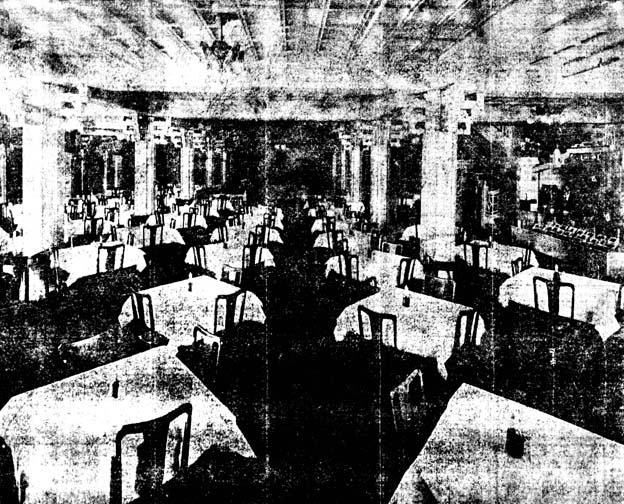

The restaurant was owned by Golden Pheasant, Inc. The officers of the company, as stated on the first ad, were:
- John Eng, President
- P.Y. Lee, Vice President
- Lester S. Lee, Secretary
- Frank W. Hong, General Manager
In July 1920, the Golden Pheasant was threatened with a lawsuit by the publisher of a song called “Just Like a Gypsy,” which their orchestra had been playing in a jazzed-up style. The Remick Music Company alleged that the sales of their sheet music had decreased because of the playing of the song. (Minneapolis Tribune, July 17, 1920) No follow-up found.
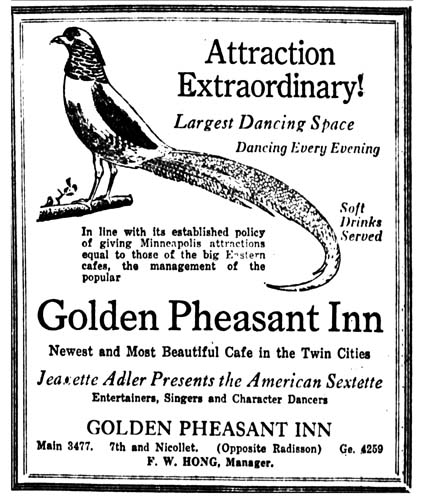
On December 25 and 26, 1920, the Inn presented Hohoano’s Hawaiians, Famous Native Musicians, with Princess Kiona, “Hula Hula Dancer.” Unfortunately the ad is too dark to reproduce!
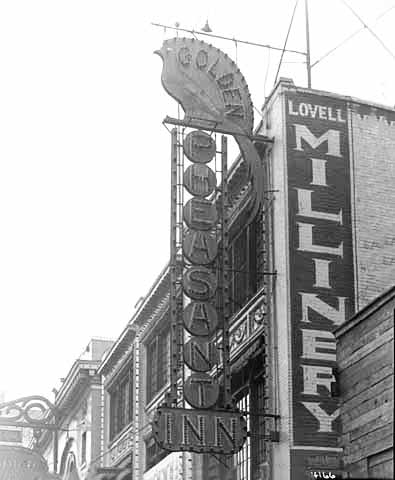
In March of 1922, the Golden Pheasant, called a “chop suey house” by the Minneapolis Daily Star, was a key player in the murder of Hong Lee, killed at the outbreak of the Minneapolis tong war. Lee was killed at the rear door of the Hip Sing tong headquarters, 717 Third Ave. So., on March 7. He had a piece of paper with the address of the Golden Pheasant in his pocket, and was wearing a suit made in Boise, Idaho, which indicated that he was a newcomer to Minneapolis. The proprietor of the Golden Pheasant was said to be the secretary of the Hip Sing tong. This may have been Frank Hong. This is a whole other subject that bears exploration. Frank Hong and the Golden Pheasant are discussed in an article in the Minnesota Monthly called “Citizen Hong,” by Joseph Hart, August 23, 2006.
On December 30, 1923, four people were arrested in a raid by Federal Prohibition officers at the Golden Pheasant Inn. One was an adult, and the other three were high school students. (Minneapolis Tribune, December 31, 1923)
In December 1923, the name of the place appears to have changed from the Golden Pheasant Inn to the Golden Pheasant Cafe. It was always owned by the Golden Pheasant Inn, Inc.
Sam J. Heiman’s Golden Pheasant Orchestra was broadcast in June 1924 on WLAG radio, but WLAG went offline on July 31. The orchestra went back on the radio when WLAG became WCCO on October 2, 1924, and remained on WCCO’s schedule for the rest of the year.
In 1925 the house band was Emmet Long’s Golden Pheasant Orchestra. Emmet Long was the younger brother of Dick Long, who was known for his career leading the Nankin Cafe Orchestra, the Shubert Theater Orchestra, and others. During World War I, Emmet was the director of the orchestral branch of the 1st Engineers’ Band of Washington, DC. He later took over his brother Dick’s position as leader of the Strand Theater’s orchestra.
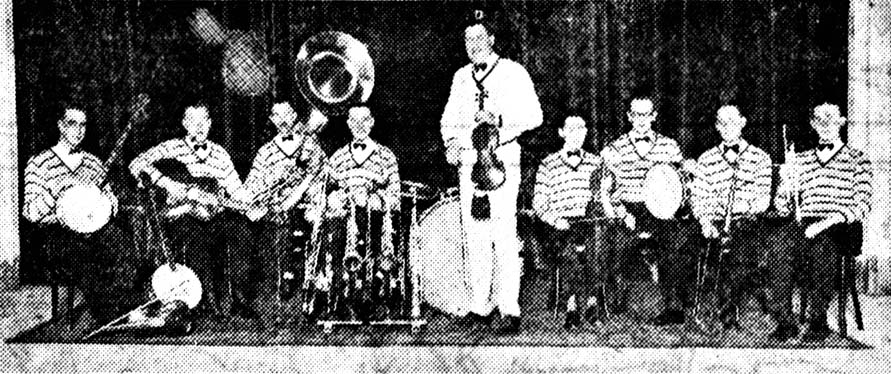
In June 1925, the Golden Pheasant’s dance hall license renewal was held up pending investigation of “reports against the place” by the police, and all dancing was forbidden until things were cleared up. (Minneapolis Daily Star, June 27, 1925) The application was denied four times in two months.
Music was broadcast from September 1925 to June 26, 1926, by Emmet Long’s Golden Pheasant Orchestra on WCCO radio.
A notice printed in the Minneapolis Tribune on June 28, 1926, announced that the cafe would be closed for renovation and open no later than September 4, 1926. It was signed by James Woo, Manager.
In July 1926, the orchestra was led by Emmet Long and could be heard on WCCO radio.
In January 1927, the Minneapolis Daily Star began a serial called “Sonia” written by Vida Hurst, which featured the Golden Pheasant in its storyline. As a promotion, the paper planned a big party for anyone named Sonia in Minneapolis and the immediate suburbs, starting at the Golden Pheasant and making the rounds to the city’s leading theaters. One article described a plane that would drop fliers advertising the event. (January 11, 1927)
In May 1927, the Golden Pheasant Orchestra was led by E.A. Sodal.
In September 1927, Walt Anderson and His Hoodlums were engaged to provide music for the Golden Pheasant. The September 10, 1927, article announcing their arrival described the “newly opened Golden Pheasant Cafe for the fall and winter season.” (Minneapolis Daily Star)
The “Hoodlums” included:
- Les Baker (or Backer)
- Eddie Bratton
- Norm Hendrickson
- Dick Hall
- Art Swalin
- Harry Wood
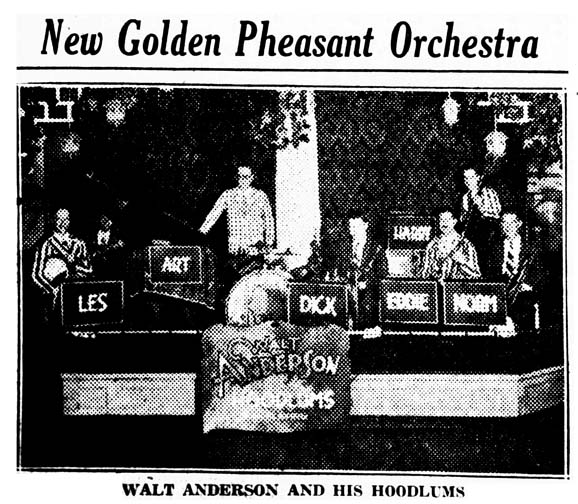
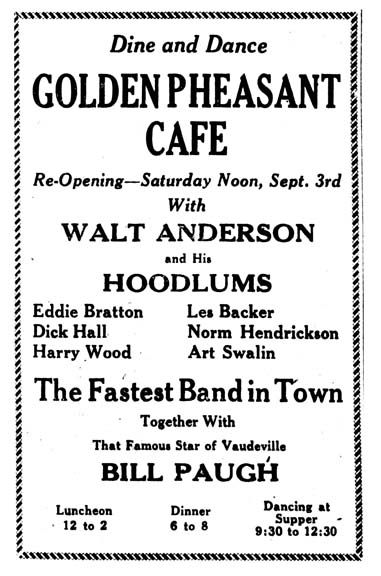
In 1927 Walter Anderson and His Golden Pheasant Hoodlums made a recording of the song “Melancholy” at the Lowry Hotel in St. Paul.
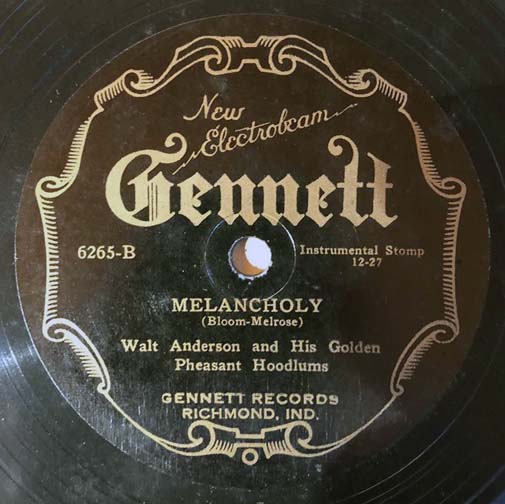
From December 1927 to March 1928, they had a regular broadcast on radio station WAMD, the forerunner to KSTP.
The Golden Pheasant’s dance hall license application had a lot of problems in 1928. First it was held up in April because the Alderman in charge of approving renewal had heard reports of alcohol being consumed on premises. (Minneapolis Star, April 27, 1928). Then it was rejected because of “immoral dancing” reported by the police, but it was an effort to force the City Council to make a study of all dance halls on this important issue. (Minneapolis Tribune, July 1, 1928) The immoral dancing consisted of “indecent wriggles.” (Minneapolis Star, June 29, 1928)
Music was broadcast from the Golden Pheasant over KSTP radio in July 1928.
The Golden Pheasant Cafe “Opened for the Season” on September 15, 1928, at noon. Music was provided by Walt Anderson and His Golden Pheasant Cafe Orchestra.
“Revelers Pay for ‘Fun’ With Municipal Fines,” the headline read on January 3, 1929. Two young men were each fined $15 for disorderly conduct for acting disorderly at the Golden Pheasant over New Year’s Eve 1928, definitely a Prohibition year. (Minneapolis Tribune)
In January 1929, an investigation of Aldermen concerning bribes came to the doorstep of the Golden Pheasant when owner Henry Woo was called to testify before the grand jury concerning his efforts to secure a dance hall license for the cafe. (Minneapolis Star, January 29, 1929)
Golden Pheasant Inn, Inc. filed for bankruptcy in April 1929.
At this point it’s difficult to say what was where. At 52 So. Seventh Street we also see:
A.G. Spalding & Bros. 1926 – 1937
After that came Linpark Clothes, from March 1939 to April 1959.
MEYERS INN
Meyers Inn was opened at 52 So. Seventh Street by Joseph G. Meyers. He had transferred his liquor license from his place at 27 So. Fourth Street, which he had run since at least 1939. Rogers Stage Bar had been a girlie show place in the Gateway, according to Will Jones, and Meyers took the redevelopment as an opportunity to relocate and establish a respectable restaurant. Meyers made $18,000 in alterations to the space and opened “quietly” in about February 1960. Jones’ review only talked about the food – no mention of entertainment. (Minneapolis Tribune, April 3, 1960)
By July 1960, Joe realized that he needed some entertainment, so he brought in Cecilia Dupree and her Escorts, reported Don Morrison, filling in for Will Jones. Cecilia was described as a “looky French girl with a Bardot hairdo,” etc. etc. (Minneapolis Tribune, July 8, 1960) Cecilia later wrote in thanking Morrison for not calling her “sexsational,” so she could send the clipping home.
RUNNING FOX INN
In 1962, an “ailing” Joseph G. Meyer sold his business to Fred L. Armstrong, Jr. The former Meyer’s Inn was opened as the Running Fox on March 13, 1962.
A new piano bar was called the Den, with Don Dodge presiding.
The smaller dining room cut the menu from 222 items to 35. Will Jones reported: (Minneapolis Tribune, March 12, 1962)
Armstrong said he will add special game dinners to the menu, with the game supplied by Armstrong Ranch, his father’s shooting club near Anoka. The new decor will include a couple of stuffed red foxes in rakish attitudes, the work of a taxidermist with a sense of humor. Armstrong’s background as saloon-keeper-restaurateur includes four years on the staff at the Normandy and a year at Michael’s.
A review in February 1963:
A relative new-comer to the list of fine downtown Minneapolis restaurants. Decor is based on English fox hunt theme and menu specialties feature exquisite game bird dinners, when in season… Lively convivial piano bar plus combo entertainment.
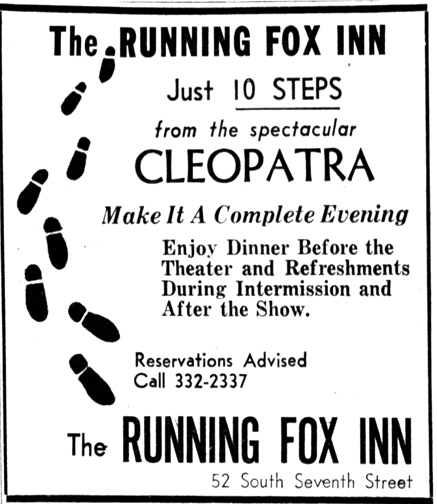
In late 1963 Armstrong sold the Running Fox to “four local business and professional men. None had had any previous restaurant experience, but they say they are having fun learning.”
The downstairs room was called the Foxhole, described by Will Jones as a “relatively small, low-ceilinged room.” (Tribune, January 9, 1964.
MEYERS INN
Apparently it didn’t work out, as the place reverted to Meyers in December 1965, and it was again called Meyers Inn.
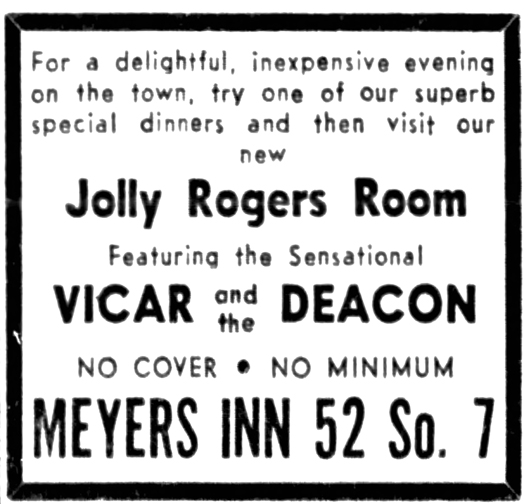
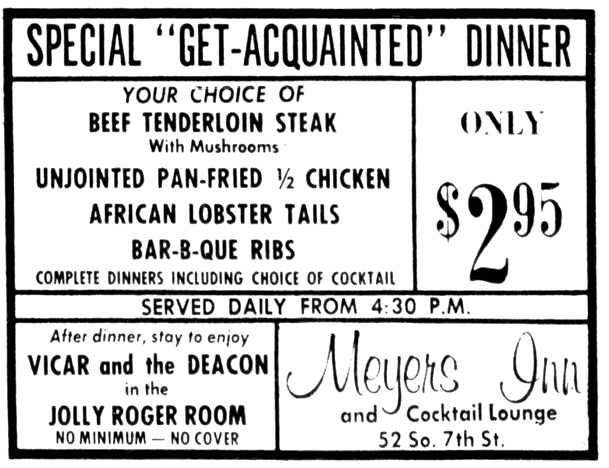
George Griak appeared in the piano bar in February 1967, followed by Dick Miller in March 1967.
In September 1967, “Master Showman” Paul Moore was on piano, vocals, and comedy detail.
Barbara Thompson followed in the piano bar from the end of 1967 into 1969.
On November 12, 1968, a five alarm fire destroyed the Kresge building at 628 Nicollet Mall. Meyers Inn was one of the businesses listed as damaged by smoke and water.
The last entertainer shown (and the last mention of Meyers Inn) was Betty Kent in August 1969.
Meyers died on December 6, 1970.
The building was demolished in October 1979.


